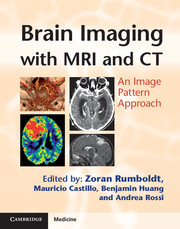Book contents
- Frontmatter
- Contents
- List of contributors
- List of abbreviations
- Preface
- Section 1 Bilateral Predominantly Symmetric Abnormalities
- 1 Hepatic Encephalopathy
- 2 Neurofibromatosis Type 1 – UBOs
- 3 Carbon Monoxide Intoxication
- 4 Pantothenate Kinase-Associated Neurodegeneration (Hallervorden–Spatz Syndrome)
- 5 Methanol Intoxication
- 6 Wilson Disease 12
- 7 Hypoxic Ischemic Encephalopathy in Term Neonates
- 8 Cryptococcosis
- 9 Gangliosidosis GM2
- 10 Leigh Disease
- 11 Deep Cerebral Vein Thrombosis (DCVT)
- 12 Creutzfeldt-Jakob Disease (CJD)
- 13 Global Cerebral Anoxia in Mature Brain
- 14 Wernicke Encephalopathy
- 15 Amyotrophic Lateral Sclerosis
- 16 Glutaric Aciduria Type 1
- 17 Subcortical Band Heterotopia
- 18 Bilateral Perisylvian Polymicrogyria (BPP)
- 19 Lissencephaly
- 20 Herpes Simplex Encephalitis
- 21 Limbic Encephalitis
- 22 CADASIL (Cerebral Autosomal Dominant Arteriopathy with Subcortical Infarcts and Leukoencephalopathy)
- 23 Megalencephalic Leukoencephalopathy with Subcortical Cysts
- 24 Canavan Disease
- 25 HIV Encephalopathy
- 26 Radiation- and Chemotherapy-Induced Leukoencephalopathy
- 27 Leukoaraiosis (Microangiopathy)
- 28 Periventricular Edema in Acute Hydrocephalus
- 29 Hypoglycemia
- 30 X-Linked Adrenoleukodystrophy (X-ALD)
- 31 Periventricular Leukomalacia (PVL)
- 32 Posterior Reversible Encephalopathy Syndrome (PRES, Hypertensive Encephalopathy)
- 33 Alexander Disease
- 34 Metachromatic Leukodystrophy
- 35 Neurodegenerative Langerhans Cell Histiocytosis (ND-LCH)
- 36 Remote Cerebellar Hemorrhage
- 37 Spontaneous Intracranial Hypotension
- Section 2 Sellar, Perisellar and Midline Lesions
- Section 3 Parenchymal Defects or Abnormal Volume
- Section 4 Abnormalities Without Significant Mass Effect
- Section 5 Primarily Extra-Axial Focal Space-Occupying Lesions
- Section 6 Primarily Intra-Axial Masses
- Section 7 Intracranial Calcifications
- Index
- References
18 - Bilateral Perisylvian Polymicrogyria (BPP)
from Section 1 - Bilateral Predominantly Symmetric Abnormalities
Published online by Cambridge University Press: 05 August 2013
- Frontmatter
- Contents
- List of contributors
- List of abbreviations
- Preface
- Section 1 Bilateral Predominantly Symmetric Abnormalities
- 1 Hepatic Encephalopathy
- 2 Neurofibromatosis Type 1 – UBOs
- 3 Carbon Monoxide Intoxication
- 4 Pantothenate Kinase-Associated Neurodegeneration (Hallervorden–Spatz Syndrome)
- 5 Methanol Intoxication
- 6 Wilson Disease 12
- 7 Hypoxic Ischemic Encephalopathy in Term Neonates
- 8 Cryptococcosis
- 9 Gangliosidosis GM2
- 10 Leigh Disease
- 11 Deep Cerebral Vein Thrombosis (DCVT)
- 12 Creutzfeldt-Jakob Disease (CJD)
- 13 Global Cerebral Anoxia in Mature Brain
- 14 Wernicke Encephalopathy
- 15 Amyotrophic Lateral Sclerosis
- 16 Glutaric Aciduria Type 1
- 17 Subcortical Band Heterotopia
- 18 Bilateral Perisylvian Polymicrogyria (BPP)
- 19 Lissencephaly
- 20 Herpes Simplex Encephalitis
- 21 Limbic Encephalitis
- 22 CADASIL (Cerebral Autosomal Dominant Arteriopathy with Subcortical Infarcts and Leukoencephalopathy)
- 23 Megalencephalic Leukoencephalopathy with Subcortical Cysts
- 24 Canavan Disease
- 25 HIV Encephalopathy
- 26 Radiation- and Chemotherapy-Induced Leukoencephalopathy
- 27 Leukoaraiosis (Microangiopathy)
- 28 Periventricular Edema in Acute Hydrocephalus
- 29 Hypoglycemia
- 30 X-Linked Adrenoleukodystrophy (X-ALD)
- 31 Periventricular Leukomalacia (PVL)
- 32 Posterior Reversible Encephalopathy Syndrome (PRES, Hypertensive Encephalopathy)
- 33 Alexander Disease
- 34 Metachromatic Leukodystrophy
- 35 Neurodegenerative Langerhans Cell Histiocytosis (ND-LCH)
- 36 Remote Cerebellar Hemorrhage
- 37 Spontaneous Intracranial Hypotension
- Section 2 Sellar, Perisellar and Midline Lesions
- Section 3 Parenchymal Defects or Abnormal Volume
- Section 4 Abnormalities Without Significant Mass Effect
- Section 5 Primarily Extra-Axial Focal Space-Occupying Lesions
- Section 6 Primarily Intra-Axial Masses
- Section 7 Intracranial Calcifications
- Index
- References
Summary
Specific Imaging Findings
In bilateral perisylvian polymicrogyria (BPP), MRI demonstrates an abnormal configuration of the cortical ribbon and irregular gray-white matter junction suggestive of multiple small gyri bilaterally around the sylvian fissures. The mildest forms of perisylvian polymicrogyria involve part of the perisylvian cortex, usually the posterior region, while the most severe forms extend beyond the perisylvian area to the frontal, occipital, and temporal lobes with a perisylvian gradient (i.e. maximal severity in the perisylvian cortex). The spectrum of cortical morphology is wide: the cortex may be normal to thick with a delicate or coarse appearance, and the cortical surface may range from bumpy and irregular to smooth. Moreover, the appearance of BPP depends on the stage of maturity/myelination of the brain: in unmyelinated regions, the inner surface of the polymicrogyric cortex looks thin and finely undulated, while in myelinated areas it looks thicker and relatively smooth. The underlying white matter usually appears decreased in volume. The sylvian fissures have an abnormally verticalized orientation extending far more posteriorly than normal into the parietal regions and may be abnormally forked along their course. The fronto-temporo-parietal opercula present an abnormally open appearance, which is frequently associated with an overlying large anomalous venous structure. CT may show abnormal sylvian fissures and thickened adjacent cortex.
- Type
- Chapter
- Information
- Brain Imaging with MRI and CTAn Image Pattern Approach, pp. 37 - 38Publisher: Cambridge University PressPrint publication year: 2012

